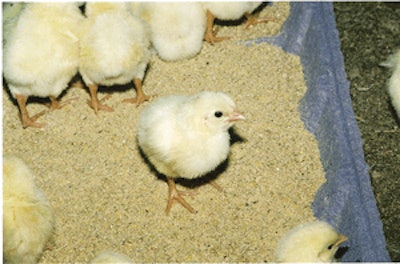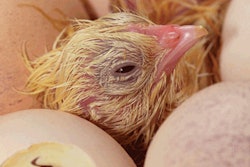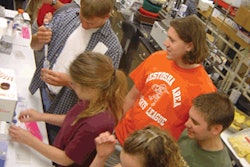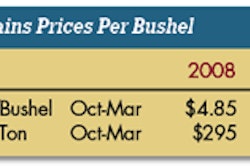
Multi-complex integrators can operate with complete decentralization, delegating responsibility and financial accountability to managers. This approach may be effective provided there is good communication between corporate and complex management, informative and relevant reporting systems and direction, usually embodied in standard operational procedures.
An alternative approach is to develop a structured framework for decision making, identifying critical performance areas and quantifiable standards of performance.
Progress in achieving objectives can be implemented by line managers in complexes with monitoring by personnel at the corporate level. A structured approach to defining objectives, standards and operational procedures can improve performance and be particularly useful during tough economic times.
The Perdue approach
Dr. Bruce Stewart-Brown, vice president responsible for aspects of flock health and product safety, Perdue Farms Inc., provided an insight into his company's system in a keynote presentation at the Midwest Poultry Federation Convention this year.
Perdue has developed a Best Practice Program (BPP), which forms the framework of planning, resource allocation and monitoring. The dynamic approach, which is loosely based on HACCP, addresses clearly defined areas of concentration. BPPs have been developed to address specific needs of a poultry company with activities on the Eastern Shore, which presents both environmental and health challenges.
For every segment of operation, the company has defined five to seven most-important activities that help to optimize efficiency. After acceptance by management and contract growers, BPPs form the basis of monitoring and mentoring activities of service personnel and their supervisors.
BPPs and their derived procedures are constantly reviewed to ensure that they contribute to improvement in performance parameters and by implication, profitability. Some aspects are emphasized and others are dropped over time, depending on the circumstances.
The program also provides an opportunity to compare complexes within Perdue and to assign specialists, including veterinarians and technicians, to assist in analytical and diagnostic activities to solve problems.
Each of the BPPs is defined by name. The activities are described, the limits are established and then monitoring programs are developed. When deviations are identified, corrective action is taken and extended into activities to prevent a recurrence.
Hierarchy of BPPs
Currently, Perdue recognizes categories of performance, welfare, food safety, biosecurity and environmental compliance as critical areas contributing to efficiency, quality and profitability in live-bird production.
With respect to food safety, Perdue has defined pest control, house sanitation, water quality, intestinal health, litter condition and moisture level as important components of the program. Each of these subcategories has areas of concentration, which are subjected to monitoring and compliance against predetermined performance values.
Monitoring intestinal health
The comprehensive program to ensure optimal function of the intestinal tract requires evaluation of a number of factors, which contribute to acceptable performance.
Control of coccidiosis
- The presence of low-grade intestinal coccidiosis is monitored as a component of routine health evaluation.
- It is generally considered that infection late in the growing cycle has a significant impact on growth and conversion. Early infection provides time during grow out to restore the integrity of the tract, and for flocks to undergo compensatory growth.
- Coccidiosis late in the growing cycle depresses live weight and generally results in wet litter, which may be associated with gangrenous dermatitis and pododermatitis.
- In addition to an effective anticoccidial medication or vaccination program, it is necessary to maintain the integrity of the immune system by appropriate immunization against IBD and Marek's disease. Anticoccidials are rotated in April and November each year to reduce the possibility of drug resistance.
- Synthetic anticoccidials are restricted to a single use on one batch of litter since resistance to chemical compounds may occur after one cycle.
Skin pigmentation
- Decreased intensity of skin pigmentation is seen as a precursor to a possible deterioration in performance of flocks. Dysfunction of the intestinal tract is associated with decreased absorption of fat-soluble vitamins and carotenoids including xanthophyll.
- Perdue assesses skin color using a Minolta color meter on specific areas between feather tracts.
Prevalence of salmonella
- At about 35 days of age, when flocks are screened for presence of pesticide residues of age, cecal contents are harvested and subjected to PCR assay. This provides a qualitative indication of the presence of Salmonella spp.
- Each week Perdue processes about 150 cecal specimens from 40 houses derived from 17 farms.
- This data is used to determine whether there is a correlation between recovery of salmonella through the monitoring program and subsequent isolation on carcasses after the chiller.
- In an attempt to determine the risk factors for salmonella carriage, data from 224 farms was obtained over a three-year period. Farms with both high and low levels of recovery were evaluated to ascertain the of significance of environmental variables.
- Factors which contributed to higher levels of salmonella carriage included improper drinker management which leads to saturation of the litter and condensation from the side walls and roof that contributes to increased litter moisture.
- Any factor that contributes to high water activity of litter will promote the proliferation of salmonella.
- Feed deprivation associated with interruption in delivery was another factor associated with recovery of salmonella from ceca of specific flocks.
Caloric conversion
- Perdue has collected data on weekly conversion over a number of years. Generally caloric conversion is the most efficient during spring and fall with cyclic deterioration through mid-summer and mid-winter.
- Excessive fluctuation, more than 50 kcal, indicates subclinical or overt intestinal infection. arly detection of deviations results in diagnostic intervention.
Quarterly health evaluation
- At regular intervals, 10 to 12 flocks representing up to four ages on a complex are subjected to clinical and post mortem examination.
- A sample of six to 10 birds is examined, with appropriate numerical scoring, for the presence of enteritis, attributed to bacterial inflectional or coccidiosis.
- The respiratory system is examined for the presence of airsacculitis and immune function is evaluated by observing the size and appearance of the bursa of Fabricius and thymus tissue.
- Clinical observations and performance are correlated with antibody titers which can be associated with efficiency of vaccination and field challenge with pathogens.
The bottom line
Formal programs to ensure appropriate management of flocks can optimize feed and caloric conversion and, help maximize profitability. Identifying critical performance areas and developing standards and criteria for subsequent evaluation form the basis of BPP programs.
Over time, an integrator can develop data that indicate trends and identify both beneficial and deleterious effects on performance.


















